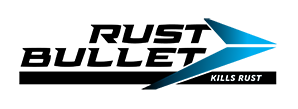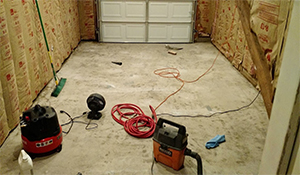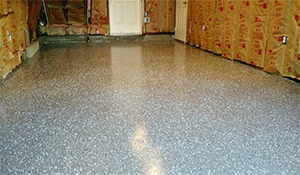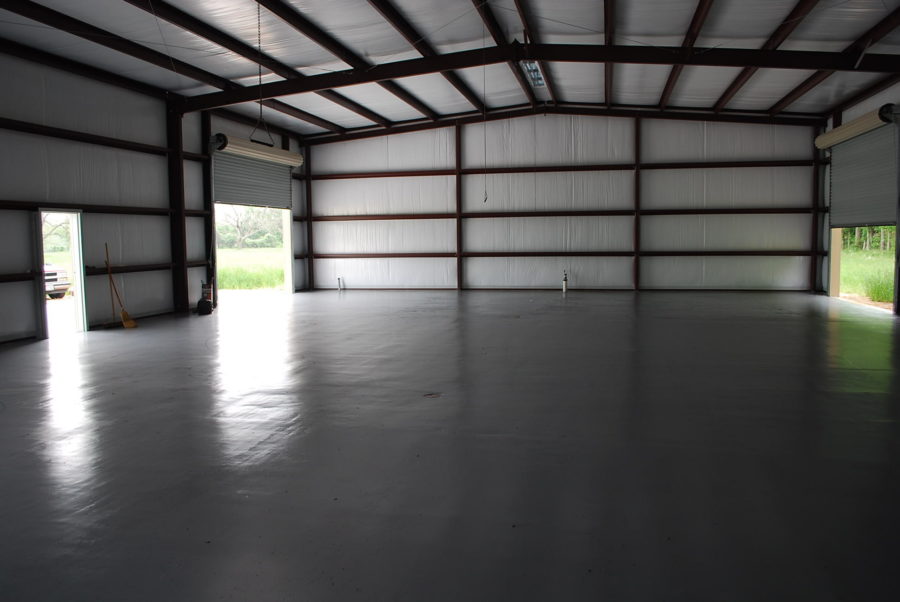From Cars to Concrete – Rust Bullet has you Covered
Rust Bullet not only improves the appearance of concrete, it provides an impervious shield allowing easy clean up of oil, grease and chemical spills along with strong protection against impacts, abrasives, and atmospheric elements. Rust Bullet’s Concrete Formula is the perfect solution to messes on your concrete floors. Use the Rust Bullet Concrete Coatings for all your concrete flooring needs including garage floors, walkways, paths and much more. We know how important it is to protect your concrete floor, and Rust Bullet for Concrete is there to protect them for years to come.
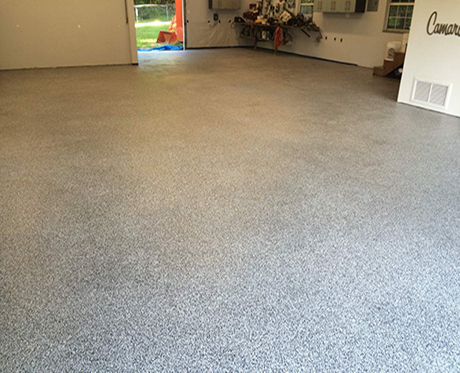
Rust Bullet versus Traditional Epoxy
Rust Bullet is a one-part multiple coat process. This means there is no messy precise mixing ratios. It is ready to use immediately as soon as you receive it. Rust Bullet is fully cured at around 72 hours after the last coat is applied. Epoxy coatings generally take 7-10 days to fully cure, some even require force curing. Additionally, Rust Bullet can cure at temperatures as low as 32°F, which is advantageous during the winter months. Epoxy coatings require temperatures above 50°F.
The preparation required to use Rust Bullet is minimal as opposed to an epoxy coating. With an epoxy, the ph must be neutral, therefore, acid etching is required, and the surface must have a coarse surface profile, and grinding is required with all applications. With Rust Bullet, all you need is a light profile, and you are good to go!
Breaches in an epoxy coating are labor intensive and will involve a large area outside the breach to be included in the repair. Rust Bullet Coatings rarely experience a breach, but when they do occur, are easily repaired with simple scuffing and application of additional coat(s) or Rust Bullet.
How Can I Apply Rust Bullet?
The process is very simple. Use a air hose or shop vac to remove loose contaminates such as dirt and dust. Spot treat any grease, oil or chemicals with a light detergent such as simple green or dish soap and water, allow to dry. If using any other type of degreaser, please contact our technical support team prior to determine if the intended product is compatible with Rust Bullet. If your floor is smooth, you may need to sand the surface. Not grind, but sand. Just get some scratches in the surface. Enough to create an anchor pattern for proper adhesion. DO NOT ACID ETCH OR POWER WASH YOUR FLOOR. If your floor has a coarse finish, then no sanding should be required. Then start painting!
A minimum of two coats is required for most applications however, porous concrete and heavy traffic areas may require additional coats. Rust Bullet is self-leveling and can fill in cracks, gaps and chips up to 1/8 inch. If a slip resistant surface is desired, sprinkle silica or similar fine sand over a tacky coat of Rust Bullet, allow just enough time for the sand to adhere, then apply the final coat of Rust Bullet. That’s it. For more detailed instructions please follow this link.
Tips and Tricks for Coating Your Concrete Floor with Rust Bullet.
- If you have a smooth floor, you may have to create a profile. To check, pour ¼ cup of water onto the concrete. If the water seeps in quickly, (30 seconds or less), then it is porous enough to accept Rust Bullet Concrete Coatings. If it beads, then you will need to create a profile.
- Do not power wash the surface. Rust Bullet is moisture sensitive. Introducing that much water will take a long time to dry. Rust of thumb is for every inch of slab; it takes 30 days for the concrete to dry., i.e. for a 3-inch slab, that would be 90 days to dry completely. If there is moisture left behind, you will have adhesion issues.
- Remove dirt, dust, etc., with an air hose, vacuum, broom etc. Rust Bullet is moisture sensitive. Spot treat oil or grease spots with a light detergent such as Dawn dish soap and water or Simple Green. Allow to dry before applying any Rust Bullet Coating.
- Use a 3/8-inch nap roller for the best coverage. Do not use foam as foam tends to slide the coating around as opposed to achieving a thin, even coat. Microfiber rollers will give the smoothest coverage. The main goal here is to achieve thin, even coats.
- The length of the roller does not matter. You may use any size roller, from the smallest to the largest. So long as it is a 3/8-inch nap roller, and you are comfortable with the application
- Start with small 4’x4′ sections at a time. This will ensure the areas are being covered evenly.
- Do your edging first. A paint brush may be used for the edging.
- Dip the roller into the roller pan several times during application to keep a wet edge. Keep in mind to not have too much paint on the roller. You will be able to feel the roller sliding, as opposed to coating. When the roller slides, that means it is not coating, and proper coverage will not be achieved.
- Rolling a “W” pattern with a medium amount of pressure on the roller handle will achieve the best coverage.
- Thin even coats are best! Do not assume that applying Rust Bullet in overly thick coats will give you better protection. It will not. In fact, if Rust Bullet is applied too thick, solvent popping occurs, and the coating will not cure properly. Again, thin, even coats.
- Seeing roller marks? There are several reasons you may see roller marks with any type of coating. When using Rust Bullet as your concrete floor coating, the roller marks generally appear because the thickness of the coating is not even throughout. As you are rolling each section, watch the already coated sections for those roller marks. If they start to appear, take the roller without adding more paint, and with no pressure on the roller handle, roll over the coated surface to even the coat out. It is like they disappear.
- Even though the roller is a great method of application, Rust Bullet can also be brushed or sprayed. We recommend an Airless sprayer with a 517-523 tip, 3000-5000 psi.
Concrete Paint Before and After
Random Broadcast Garage Floor
This single car garage was coated with Rust Bullet for concrete. Then flakes were sprinkled onto the last wet coat. After the last coat was dry to the touch, then the Rust Bullet Clear Shot (we now have DuraGrade Clear to seal flake) was applied to seal in the flakes.
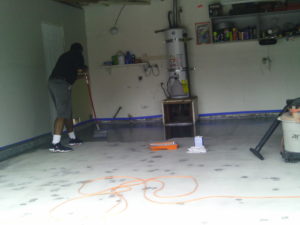
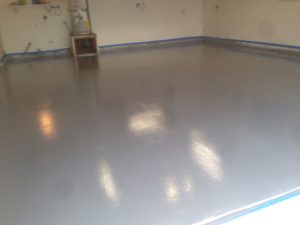
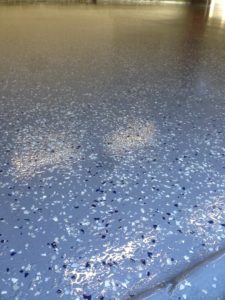
Only two coats for Rust Bullet for concrete was applied to this floor. This satisfied customer did an inspection and checked for any oils, grease, grime, spot treated then removed the contaminates, allowed the surface to dry, then applied Rust Bullet for Concrete. Looks brand new. And no acid etching required.
